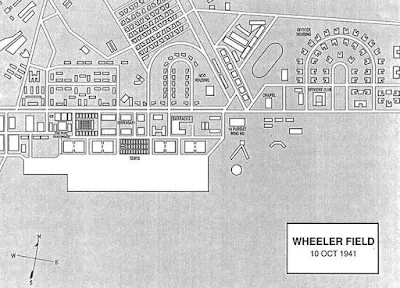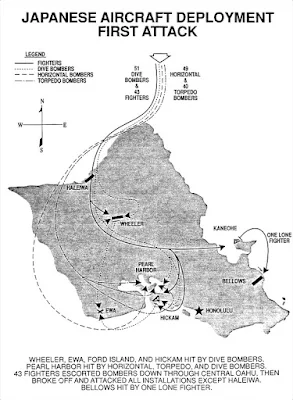NAVY DEPARTMENT
OFFICE OF THE CHIEF OF NAVAL OPERATIONS
WASHINGTON, Feb. 15, 1941
Op-30Cl-AJ
(SC) N20-12.
Serial 09330.
From: The Chief of Naval Operations
To: The Commander-in-Chief, Pacific Fleet
Subject:: Anti-torpedo baffles for protection against torpedo plane attacks, Pearl Harbor.
Consideration has been given to the installation of A/T baffles within Pearl Harbor for protection against torpedo plane attacks. It is considered that the relatively shallow depth of water limits the need for anti-torpedo nets in Pearl Harbor. In addition the congestion and the necessity for maneuvering room limit the practicability of the present type of baffles.
Certain limitations and considerations are advised to be borne in mind in planning the installation of anti-torpedo baffles within harbors, among which the following may be considered:
A minimum depth of water of seventy-five feet may be assumed necessary to successfully drop torpedoes from planes. One hundred and fifty feet of water is desired. The maximum height planes at present experimentally drop torpedoes is 250 feet. Launching speeds are between 120 and 150 knots. Desirable height for dropping is sixty feet or less. About two hundred yards of torpedo run is necessary before the exploding device is armed, but this may be altered.
There should be ample maneuvering room available for vessels approaching and leaving berths.
Ships should be able to get away on short notice.
Room must be available inside the baffles for tugs, fuel oil barges and harbor craft to maneuver alongside individual ships.
Baffles should be clear of cable areas, ferry routes, and channels used by shipping.
Baffles should be sufficient distance from anchored vessels to insure the vessels' safety in case a torpedo explodes on striking a baffle.
High land in the vicinity of an anchorage makes a successful airplane attack from the land side most difficult.
Vulnerable areas in the baffles should be so placed as to compel attacking planes to come within effective range of anti-aircraft batteries before they can range their torpedoes.
Availability of shore and ship anti-aircraft protection, balloon barrages, and aircraft protection.
Availability of naturally well protected anchorages within a harbor from torpedo plane attack for a number of large ships. Where a large force such as a fleet is based, the installation of satisfactory baffles will be difficult because of the congestion.
As a matter of interest the successful attacks at Taranto were made at very low launching heights at reported ranges by the individual aviators of 400 to 1300 yards from the battleships, but the depths of water in which the torpedoes were launched were between 14 and 15 fathoms. The attacks were made in the face of intensive and apparently erratic anti-aircraft fire. The eastern shore line of the anchorage and moorings were protected by numerous balloon barrages, but there was no trawler borne balloon barrage to the west. The torpedoes were apparently dropped inside of the nets, probably A/T nets.
It is considered that certain large bays and harbors, where a fleet or large force of heavy ships may be anchored and exposed with a large body of water on an entire flank, should have that flank protected by a series of baffles if the water is deep enough for launching torpedoes. The main fleet anchorage at Scapa Flow, for instance, has an A/T net extending slightly to the north of a line between Calf of Flotta and Cava Island protecting the main fleet anchorage. The depth of water where this net is laid is approximately 17 fathoms. On the other hand constricted harbors, in which practically all available space is taken up by anchorages, and which is relatively deep probably must depend upon other defense measures. It might be possible and practicable to provide in some places, which are not protected by relatively shallow water, anti-torpedo baffles practically surrounding a limited number of berths or large ships, such as battleships or carriers. An extreme example of this is furnished at the present time by the French at Dakar, where double nets surround the Richelieu; she is placed similarly as in a dry dock, and evidently would have to open a section of the net to be hauled clear. The depth of water at Dakar, however, is very shallow.
The present A/T nets are very expensive extremely heavy, their heavy anchors and moorings take up about 200 yards space perpendicular to the line of the net, take a long time to lay, and are designed to stand up under heavy weather conditions. There is apparently a great need for the development of a light efficient torpedo net which could be laid temporarily and quickly within protected harbors and which can be readily removed. It is hoped that some such net can be developed in the near future.
Recommendations and comments of the Commander-in-Chief are especially desired.
(s) H. R. Stark.
H. R. STARK.
Copy to
CinC Atlantic Fleet.
CinC Asiatic Fleet.
NAVY DEPARTMENT
OFFICE OF THE CHIEF OF NAVAL OPERATIONS
WASHINGTON
CONFIDENTIAL
Op-30Cl-AJ
(SC)N20-12
Serial 010230
February 17, 1941
From: The Chief of Naval Operations
To: The Commandant, First Naval District
The Commandant, Third Naval District
The Commandant, Fourth Naval District
The Commandant, Fifth Naval District
The Commandant, Sixth Naval District
The Commandant, Seventh Naval District
The Commandant, Eighth Naval District
The Commandant, Tenth Naval District
The Commandant, Eleventh Naval District
The Commandant, Twelfth Naval District
The Commandant, Thirteenth Naval District
The Commandant, Fourteenth Naval District
The Commandant, Fifteenth Naval District
The Commandant, Sixteenth Naval District
The Commandant, Naval Station, Guantanamo
Subject: Anti-torpedo baffles for protection against torpedo plane attacks.
In previous correspondence the Commandants and Local Joint Planning Committees have been requested, where considered necessary, to submit recommendations concerning the employment of nets and booms in their defenses. In nearly all cases the recommendations received were limited to harbor entrances. One of the reasons for this was that the Department, after previously making studies of many harbors, submitted certain proposals for consideration by the Districts, but did not specifically propose any protection against torpedo plane attacks.
The Commandants and Local Joint Planning Committees are requested, if they have not already done so, to consider the employment of and to make recommendations concerning anti-torpedo baffles especially for the protection of large and valuable units of the fleet in their respective harbors, and especially at the major fleet bases.
In considering the use of A/T baffles, the following limitations, among others, may be borne in mind:
A minimum depth of water of seventy-five feet may be assumed necessary to successfully drop torpedoes from planes. About two hundred yards of torpedo run is necessary before the exploding device is armed, but this may be altered.
There should be ample maneuvering room for vessels approaching and leaving berths.
Ships should be able to get away on short notice.
Room must be available inside the baffles for tugs, fuel oil barges and harbor craft to maneuver alongside individual ships.
Baffles should be clear of cable areas, ferry routes, and channels used by shipping.
Baffles should be sufficient distance from anchoraged vessels to insure the vessels safety in case a torpedo explodes on striking a baffle.
High land in the vicinity of an anchorage makes a successful airplane attack from the land side most difficult.
Vulnerable areas in the baffles should be so placed as to compel attacking planes to come within effective range of anti-aircraft batteries before they can range their torpedoes.
Availability of shore and ship anti-aircraft protection balloon barrages, and aircraft protection.
Availability of naturally well protected anchorage within a harbor from torpedo plane attack for a number of large ships. Where a large force such as a fleet is based, the installation of satisfactory baffles will be difficult because of congestion.
R.E. INGERSOLL
Acting
- - - - - - - - - - - - - -
Copy To:
Cinc, Pacific
Cinc, Atlantic
Cinc, Asiatic
C.O.Nav.Net Depot, Tiburon
C.O.Nav.Net Depot, Newport
BuOrd
OP-1













